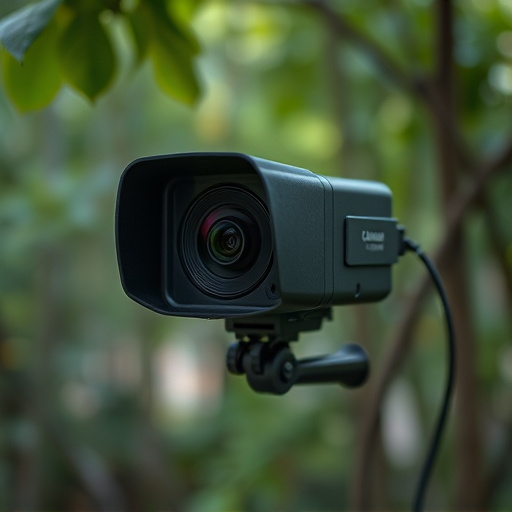RF detectors effectively identify small hidden cameras in bedrooms by analyzing radio signals. Strategically placing cameras and prioritizing privacy laws is essential. Calibrating detectors and interpreting results helps locate hidden cameras. Ethical deployment demands consent, transparency, and adherence to local regulations for Small Hidden Cameras for Bedroom use.
Uncover the power of RF detector sweeps for identifying hidden cameras in your bedroom with this comprehensive guide. Learn how RF technology detects wireless signals, making it a game-changer for locating small, discreet cameras. From understanding the tech to setting up and interpreting results, we’ll walk you through the process. Discover optimal placement strategies for small hidden cameras in bedrooms while considering ethical implications. Enhance your privacy awareness with practical tips tailored to this modern concern.
- Understanding RF Detector Technology for Hidden Cameras
- Identifying Potential Locations for Small Bedroom Cameras
- Setting Up and Calibrating Your RF Detector Device
- Visualizing Results: Interpreting Detectors' Outputs
- Ethical Considerations When Using Hidden Cameras in Bedrooms
Understanding RF Detector Technology for Hidden Cameras
RF (Radio Frequency) detector technology plays a pivotal role in identifying and detecting hidden cameras, especially those designed to be miniature and discreet, like small hidden cameras for bedroom setups. These devices operate by scanning and analyzing radio signals emitted from various sources, including covert recording devices. The RF detector sweeps through different frequencies, picking up on the unique signals that many hidden cameras emit, making them an effective tool for privacy protection.
When it comes to locating small hidden cameras in bedrooms or any space, understanding how these devices work is key. RF detectors can pinpoint the exact location of a hidden camera by zeroing in on interference caused by its radio transmission. This technology ensures that users can detect even the smallest and most advanced surveillance equipment, providing peace of mind in private settings like bedrooms where security and privacy are paramount.
Identifying Potential Locations for Small Bedroom Cameras
Identifying potential locations for small hidden cameras in a bedroom requires a keen eye and understanding of privacy concerns. Since small bedroom cameras are designed to be discreet, they can be placed in various strategic spots. Consider areas near windows or doors where light is abundant, as this can aid in capturing clear footage. Curtains or blinds can also serve double duty by providing cover for the camera while allowing natural light to enter the room.
Additionally, small hidden cameras for bedroom setups can be positioned on nightstands, bookcases, or even inside ceiling lights fixtures. These locations offer both visual coverage and minimize detection due to their mundane appearance. Remember that placement should always respect privacy laws and the comfort of those in the space, ensuring a harmonious balance between security and personal boundaries.
Setting Up and Calibrating Your RF Detector Device
Setting up and calibrating your RF (Radio Frequency) detector device is a crucial step in your hidden camera tutorial, especially if you’re using small bedroom cameras. Begin by ensuring your device is compatible with the frequency range of the small hidden cameras you intend to detect. Most modern devices cover a wide range, but double-check specifications to avoid any disappointment. Next, calibrate the sensor by placing it near known RF emitters like mobile phones or Wi-Fi routers. This process ensures accurate readings and helps eliminate false alarms.
During setup, position your detector strategically within the space you want to monitor, typically in a central location for maximum sensitivity. Consider factors like room size and layout, as well as potential interference from other electronic devices. Proper calibration and placement significantly enhance the device’s ability to detect small hidden cameras, making it an effective tool in your tutorial and ensuring you capture the desired footage without interference.
Visualizing Results: Interpreting Detectors' Outputs
Once you’ve conducted an RF detector sweep, it’s crucial to understand and interpret the results. The outputs from these detectors are visual representations that help you identify potential hidden camera locations within your bedroom or any other space. Typically, these tools display signals or patterns on a screen, indicating the presence of wireless devices, including small hidden cameras that transmit data through radio frequency (RF) signals.
When dealing with small hidden cameras for bedroom surveillance, these visual cues can vary. A strong, sudden peak in signal strength could indicate an active camera, whereas a consistent but faint signal might suggest a nearby device or potential false positive. It’s essential to know the baseline RF noise levels of your environment and understand what constitutes an anomalous reading. This interpretation step ensures that you’re making informed decisions and not wrongly accusing harmless devices as hidden cameras.
Ethical Considerations When Using Hidden Cameras in Bedrooms
When utilizing small hidden cameras in bedrooms, ethical boundaries must be carefully considered. Installing surveillance equipment in someone’s private space without their consent is a significant invasion of privacy and can lead to severe legal repercussions. It’s crucial to respect individual privacy rights and ensure any use of hidden cameras aligns with local laws and regulations regarding surveillance.
Using small hidden cameras for bedroom monitoring should only be done with explicit permission from the occupants, especially in situations where there are reasonable concerns about safety or security. Transparency and open communication are key; individuals should be made aware that they are being recorded to avoid any potential discomfort or mistrust. This approach fosters an environment of trust and ensures the ethical use of technology for privacy protection.
When it comes to small hidden cameras for bedrooms, understanding RF detector technology is key. By identifying potential locations, setting up and calibrating your device effectively, and interpreting the outputs accurately, you can ensure a discreet and ethical surveillance setup. Remember to always consider the privacy of occupants and adhere to legal guidelines when using such devices.
